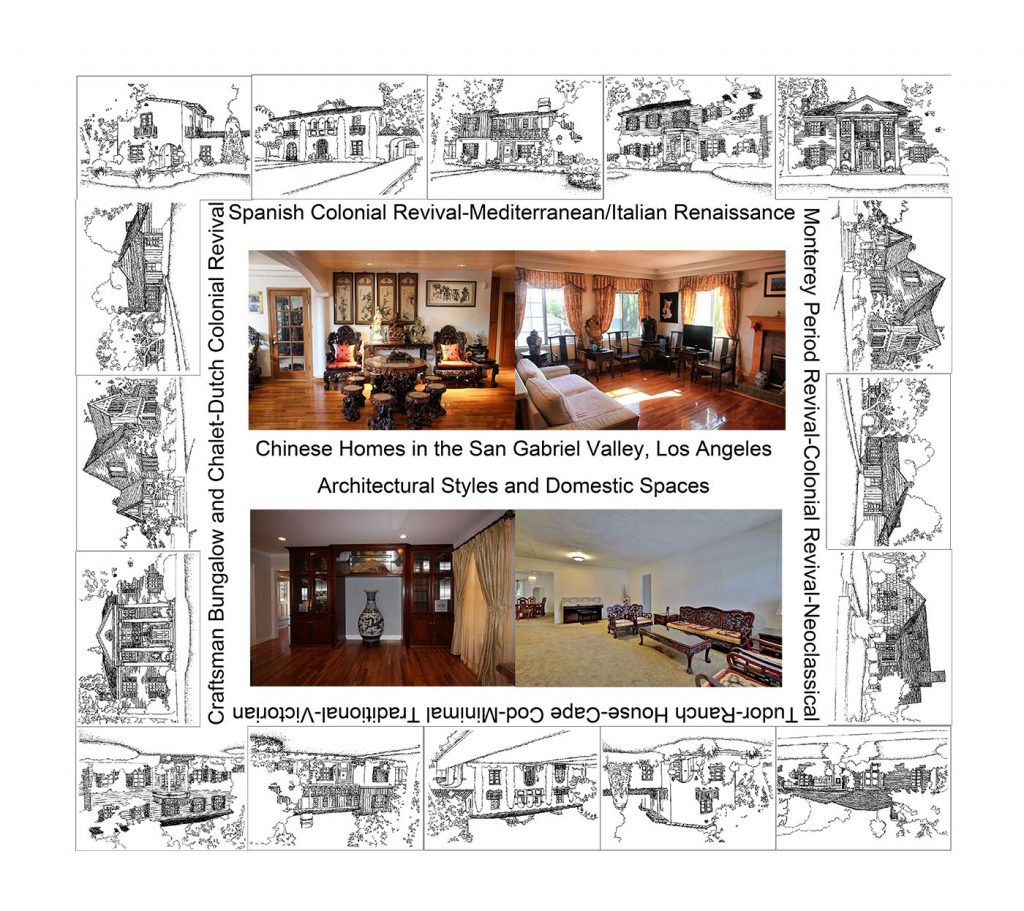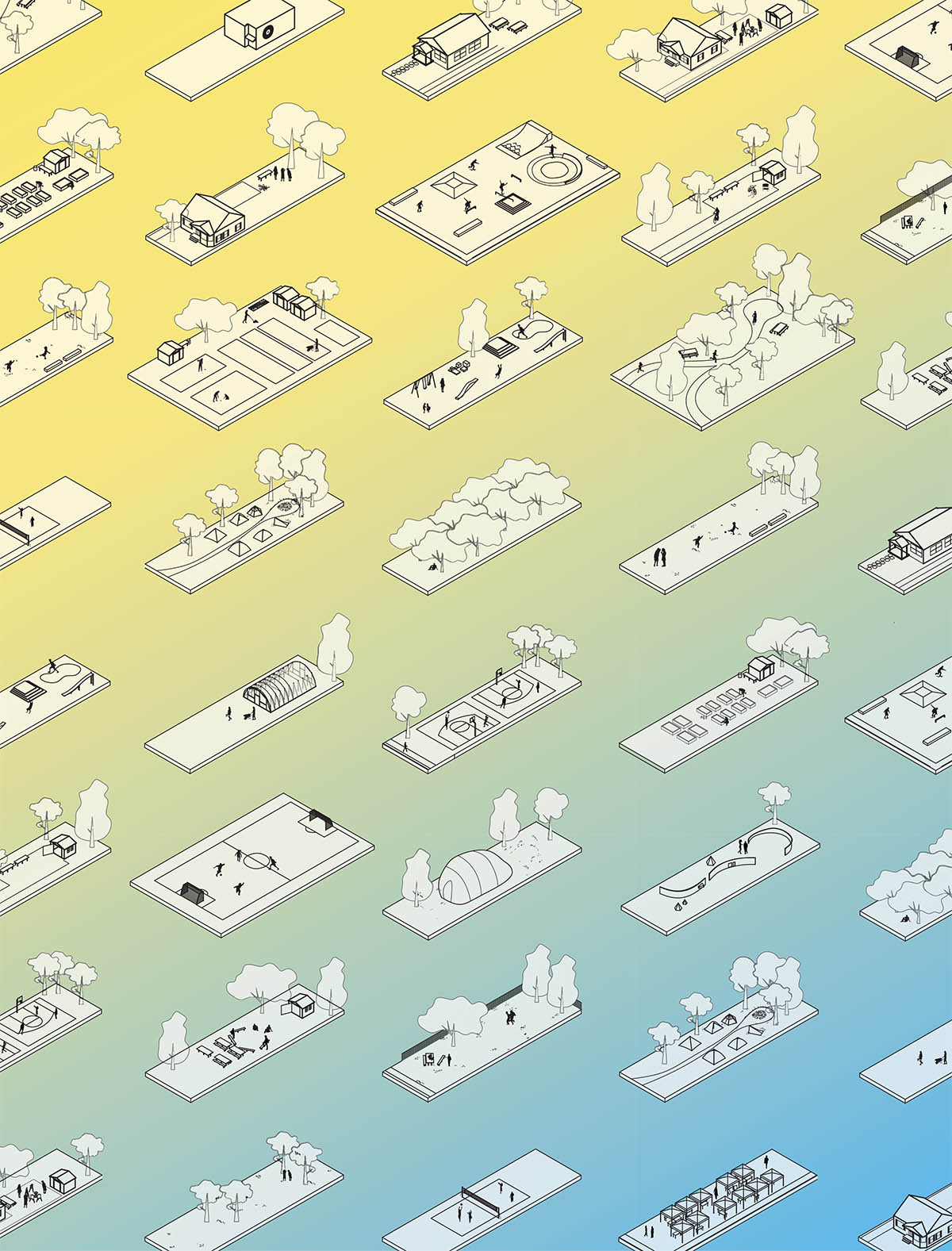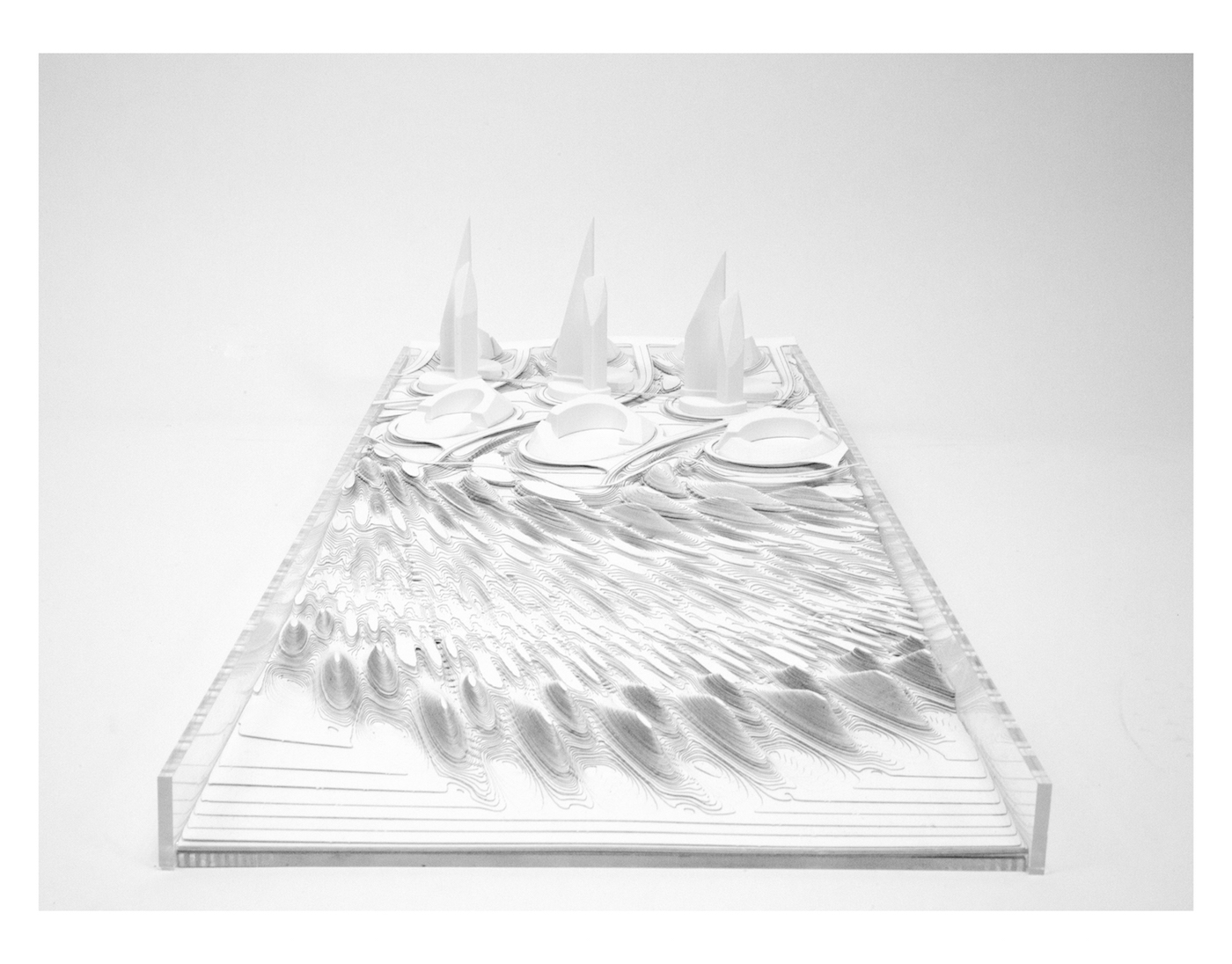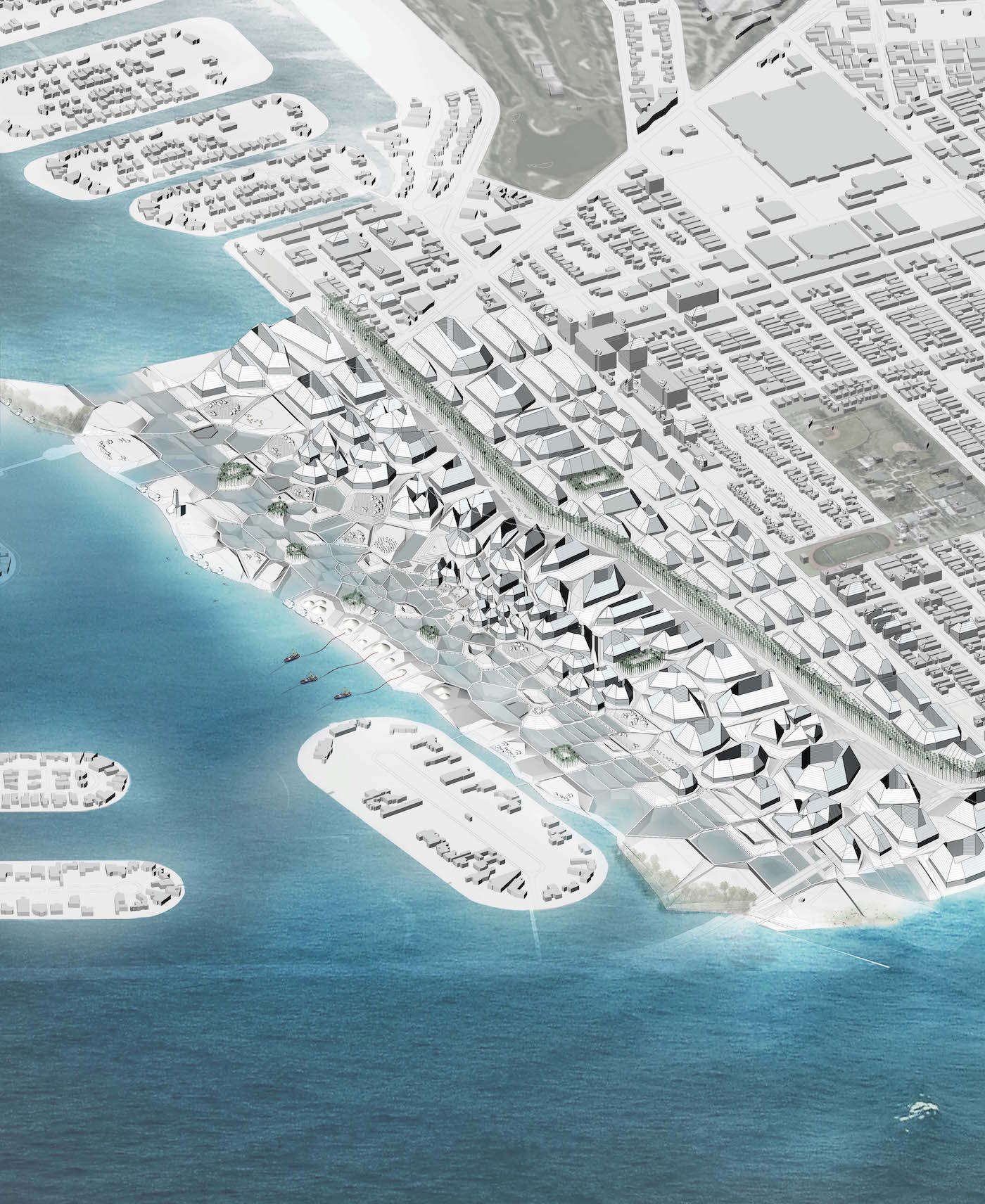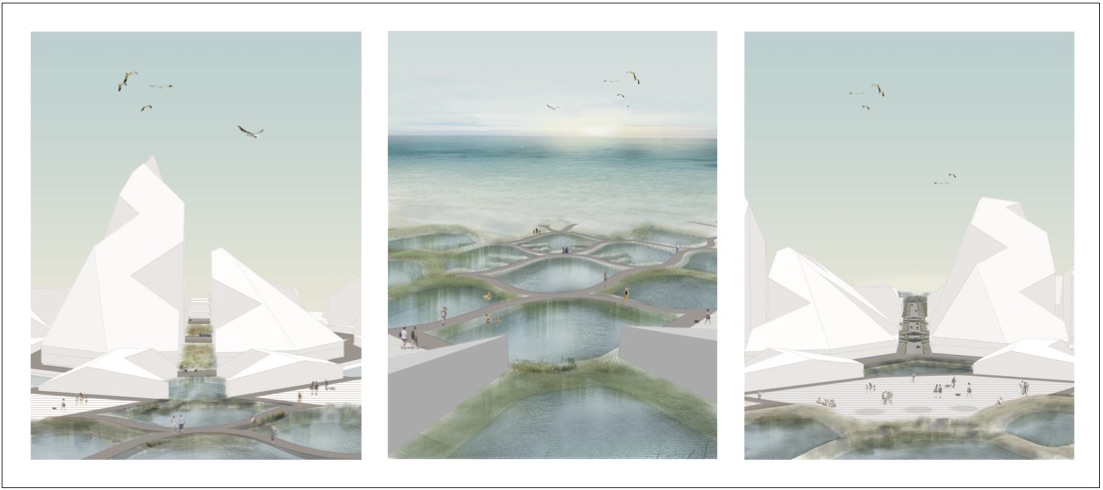Detroit’s Got Lots: The Generation Z Guide to Warrendale’s Vacant Lots
Ann Salerno (MLA I ’18)
Warrendale—like many of Detroit’s neighborhoods—has a lot of vacant lots. Almost every street has empty houses and lots. With all of these lots, this neighborhood can be hard to love, and even harder to understand, because of how empty it feels. For refugees, this semi-suburban, empty feeling landscape is incredibly difficult to understand and feel a part of. For the local community, this state of vacancy can be demoralizing. This project aims to empower and give agency to teenagers—both refugees and locals—by leveraging those vacant spaces to create a sense of ownership of the neighborhood. Teenagers, or Generation Z, are part of all communities in Detroit. Their influence on trends, as well as their presence on social media and technological savvy, makes them perfect people to begin to imagine a different Warrendale.
This booklet is a guide to the vacant lots of Warrendale. It will try to make sense of how Warrendale came to look the way it does, and try to answer some of the main questions about vacant lots. How did they get there? Who owns them? Why haven’t they changed? How are they used today? Why do they look this way? Secondly, this booklet, along with the use of social media, will help illustrate potential futures of these lots and show how teens can help shape the future of these lots.
Street Dreams: Redefining Revitalization at West Warren Avenue
Natasha Hicks (MUP/MDes ’19) and Simone Hodgson (MUP ’18)
This project explored what inclusive commercial corridor revitalization might mean and look like for both the existing predominantly Black community and the incoming immigrant and refugee community in Warrendale, Detroit. After on the ground research and surveying locals it became clear that Warrendale is a very unique neighborhood, and yet is almost entirely invisible and unknown to other Detroiters. A thorough analysis of the current conditions on West Warren Ave. (Warrendale’s key commercial corridor) revealed some of the neighborhood’s strengths, but also uncovered the weaknesses at play: low levels of community capacity, underlying tensions around racial/ethnic stereotypes and inequities in business ownership, a near absence of community identity, and little outside investment.
By unearthing a street rich in history, with deeply-rooted challenges, and full of powerful stories, “Street Dreams: Redefining Revitalization at West Warren Ave.” contemplated how the prevalence of vacant commercial properties could be considered an opportunity to build community capacity, bring diverse groups together, and create a neighborhood identity in Warrendale. This project designs a vision for a new community organization called Street Dreams Coalition that takes elements from three different types of organizations—Community Development Corporations, Business Improvement Districts, and a Commercial Community Land Trusts—to create a new model for building community power and advocacy in Warrendale.
Growing-Up Warrendale: Trauma-Informed Landscape Operations for Neighborhood Intersections
Ana Cristina Garcia (MLA I ’17)
The neighborhood of Warrendale in Detroit is transforming into a receiving community for an arriving Arab refugee and immigrant community. Although the receiving and arriving communities share little cultural or ethnic similarities, both communities have had to endure adverse and traumatic experiences. Trauma is defined by a prolonged exposure to toxic stress. Toxic stress is the body’s continued activation of physiological stress responses and, can be particularly damaging to children’s psychosocial well being. The point of departure of this project is the understanding that trauma, although stemming from different experiences in each community, has a shared neuro-developmental effect in children. This project focuses on the potential of the neighborhood to mediate the traumas of children in both the receiving and the arriving communities. The aim is to identify features in the neighborhood that trigger and contribute to a stress-response and transform them into places of physical and emotional safety for children.
Hydrological Urbanization
by Andrew Madl (MLA II ’17) The city of Miami Beach finds itself at a complex intersection of natural phenomena and fluxes that choreograph and organize systematically to provide grounds for potential failure but also the potential to provide for the optimization/reinterpretation of the current urbanism occupation. These networks that govern the function and existence of Miami Beach present themselves not as negative entities, but rather as a framework for opportunity. The various concrete and abstract actions at play can be exposed, and, to a degree, exploited to provide the necessary theoretical framework for a new urbanism that maintains the current identity of Miami Beach while promoting a new explication of the projected future of the spatialization of the settlement. Rising ocean levels, increasing magnitude of storm events, and allocation for new infrastructure drive the re-tooling of the current grid typology and associated development standards. Factors associated with the deconstruction of oceanic systems and ecosystems such as pH levels, salinity levels/gradients, plant community patterns and landform typologies can be leveraged and reimagined to fit the needs of both the urban and native systems at play. These factors, when choreographed together, can produce a new city grid arrangement that allows for social and urban based occupations to intersect the needed performative operations of the vernacular landscape conditions associated with Miami Beach. Metrics based on flow rates/intensities can formulate a surface of multiplicity that plays to the governing and self-organization of an active urban surface that responds to characterizing open space and fully programmed space based on the requirements of the deconstructed parameters of the vernacular systems at play. Ultimately, this produces a stance on urbanism that provokes the need for development and policy to be based not purely upon economic systems but rather on the spatialization of the various simulated data-driven natures that govern the city.
Oblique Plan
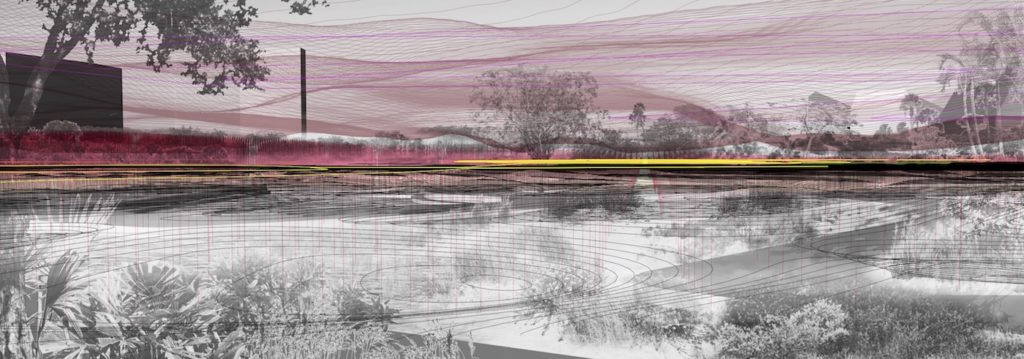
Ground Perspective
Types in the Park
Boxia Wang (MLA I ’17)
As sea level rise and storm events continue to threaten the ecological and cultural environment of Miami Beach, this project seeks a strategy to restore the resilience of its landscape while still maintaining the city’s vitality.
The overall strategy is to elevate part of urban fringe along the bay, as “waterproof” zones for development of tourist resort while the area closer to the bay are reserved for ecological adaptation uses, serving as a barrier and protector for the inland zones.
Miami Beach used to be a mangrove swamp adapted to the local environment. In order to restore its ecological capacity, studies are conducted to identify four mangrove communities with different ability to handle sea level rise. Accordingly, four different types of island landforms are designed to each accommodate a particular mangrove community. Finally, these mangrove islands are organized and distributed within the radial grid system, creating layers of protection for the coastline.
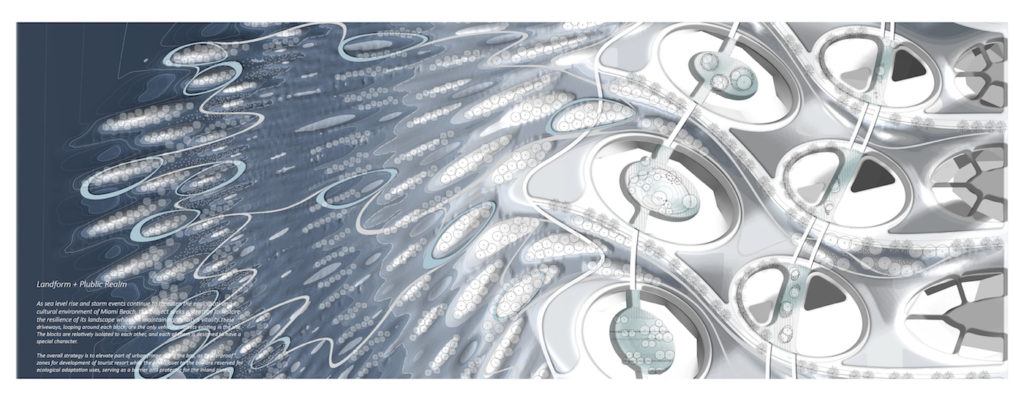
Biscayne Barnacles
Sonny Meng Qi Xu (MLA I AP/MArch II ’18)
The project proposes an urban design strategy for Miami in which the landforms, building forms and public spaces work together and perform systematically to create a more coastal resilient city. In response to rising sea-level and storm events, the formations of the ground and the building envelopes are shaped by an ecological understanding, social consciousness and by applying heliomorphism. Through analyzing the form, function and aggregation of the barnacle, I aim to mimic how the successful and abundant sea creature found in the tidal zone, holds and stores water. The clustering of the mounds create platforms for the buildings and public spaces for the people. The amalgamation of the building forms allow for the hybridization of typologies. The pools and courtyards collect and store rain and sea water in response to rising sea level and storm event. The project aims to build a more resilient and ecologically aware Miami shoreline, meanwhile, create a new cultural identity and urban realm for the city.
Paradise in Process
Jessy Yang (MAUD ’17)
This project sees the issue of imminent sea level rise and the real estate boom in Miami Beach as opportunities to reshape the future collective image of the city along Biscayne Bay.
The project deploys a new grid framework along the city’s west coast that opens up access to the waterfront from the existing set of privatized superblocks, crenelates a resilient waterfront to protect from future storm surges, and stages the future developments of the city through a consistent formal language, one informed by sea rise adaptation and solar performance.
Living Landforms
Ziwei Zhang (MLA I ’17)
As sea levels rise, Miami must adopt new urban models that embrace the incoming waters. In the coming decades, new construction of seawalls, breakwaters, and other coastal defense systems must be coupled with green infrastructure to maximize resilience and local ecological assets.
This project integrates landform as a new kind of infrastructure that simultaneously informs the city’s future urban block structure. New landforms shaped by flow dynamics and habitat formation provide a landscape structure to avert seawater, absorb tidal water, and hold stormwater. Further inland, a combination of sunken inner courtyards, elevated roads, and elevated buildings create a new drainage system that augments existing engineered solutions and streamlines public to private thresholds.
Pharma 2100
Anesta Iwan (MDE ’19)
Is our country focused more on fixing our problems or on preventing our problems?
Inspired by the way the U.S. healthcare is portrayed in Matthew Heineman and Susan Froemke’s documentary “Escape Fire,” the purpose of this study is to analyze the global pharmaceutical industry and gauge where the emphasis on funding lies between therapeutic and preventive methods in our health. The intended audience is a mix of governmental leaders, related R & D start-ups, and curious global citizens who care about the trajectory of their healthcare system.
The following data is based on a small sampling of the currently (2017) active pharmaceutical companies around the world. About a 10% random sample were taken from each bucket of different sized companies (measured by the number of employees). This data was obtained in 2017 through the Orbis Database, the World Bank Data, and the Bloomberg Global Health Index.
Critical Conservation of Chinese-American Culture: The story of Los Angeles’s five Chinese neighborhoods
Hao Ding (MDes ’17)
In this project, I study the differences between Los Angeles’s Chinatown community and San Gabriel Valley Chinese community in their histories, demographics, and the ways through which culture and identity are expressed in each place. Although both are Chinese communities, they have evolved into very different places through different processes under different socio-political circumstances.
Through this project, I intend to question the meaning of the Chinese-American identity to these two communities and ground the issue of historic and cultural conservation in an understanding of power politics. These issues are very relevant to the social justice regarding ethnic minority populations in the United States and also many other countries. The ways through which historic and cultural heritages are constructed and used in these two places reveal underlying forces that have been shaping the built environment as well as affecting people living in these neighborhoods.
I combine field observation, historic and archival research together with current spatial patterns and public policies to understand issues of demographic composition, racial discrimination as well as identities and cultures.
I conclude that historic narratives and cultural heritages have been constructed to exoticize, discriminate, and exclude the Chinese-American community who still lack political power despite their growing economic power.
